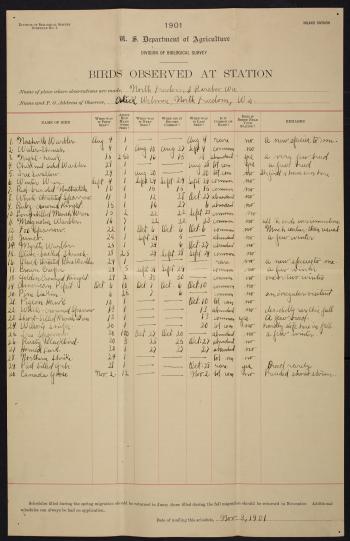On National Bird Day, a look at the long and illustrious ornithology career of Smithsonian Secretary Alexander Wetmore.

This curious, thirteen-year-old boy with a notebook and a love of birds grew up to be Smithsonian Secretary Alexander Wetmore (1886-1978). Wetmore, a renowned ornithologist, spent his long and successful scientific career studying birds across the globe—but he started with the birds he found in his own childhood backyard in North Freedom, Wisconsin.
Though his first field observation was recorded at age eight, in Florida (where he wrote about seeing a pelican during a family vacation in 1894), a majority of Wetmore’s early bird watching took place as he watched the sky from local plum orchards, marshes, and forests. His experience with the Red-headed Woodpecker marks his first published scientific paper, printed in the “For Young Observers” column in a 1900 issue of Bird-Lore magazine. For the next several years, young “Alick” Wetmore would take detailed notes of bird observations. Kept in neat columns, written in painstakingly careful beginners’ cursive, Wetmore wrote about the birds he saw—if he watched them “singing” or “calling” or “feeding,” their common names, and the dates, sometimes marked daily.

By 1901, Wetmore was filling out records to send to the US Department of Agriculture’s Bureau of Biological Survey (succeeded by the US Fish and Wildlife Service). Nine years later, Wetmore got a job with the same department. While still in college at the University of Kansas, Wetmore spent his summer breaks assisting Biological Survey field investigations in Wyoming and Alaska. After graduation, Wetmore was promoted to assistant biologist, where he began studying the eating habits of North American birds. He traveled across the United States observing birds, taking notes with the same practiced skill he exhibited as a boy. Wetmore’s passion for ornithology ultimately took him on field trips across the world—through Europe, to South America and the Pacific Islands, studying everything from bird migration to the agricultural impact of bird life.

Wetmore’s rising administrative ranks at the Smithsonian did not stop him from doing what he loved most—field research. Wetmore continued his expedition trips and research abroad, particularly to Panama. His years of research resulted in the publication of his book The Birds of the Republic of Panama. This book on birding—at over 600 pages—comes a long way from Wetmore’s first published set of observations, looking carefully at a woodpecker in the Wisconsin trees. But for Wetmore, that same curiosity and passion at the heart of all of his research, always stayed the same.
Explore Alexander Wetmore’s early field work and help transcribe it for researchers—both present and aspiring!—at the Smithsonian Transcription Center.
Related Resources
Alexander Wetmore, Smithsonian Institution Archives
Wetmore Panama Expeditions Overview, Smithsonian Institution Archives, YouTube
Bird-Lore: A bi-monthly magazine devoted to the study and protection of birds and mammals, 1900, HathiTrust
Produced by the Smithsonian Institution Archives. For copyright questions, please see the Terms of Use.

Leave a Comment